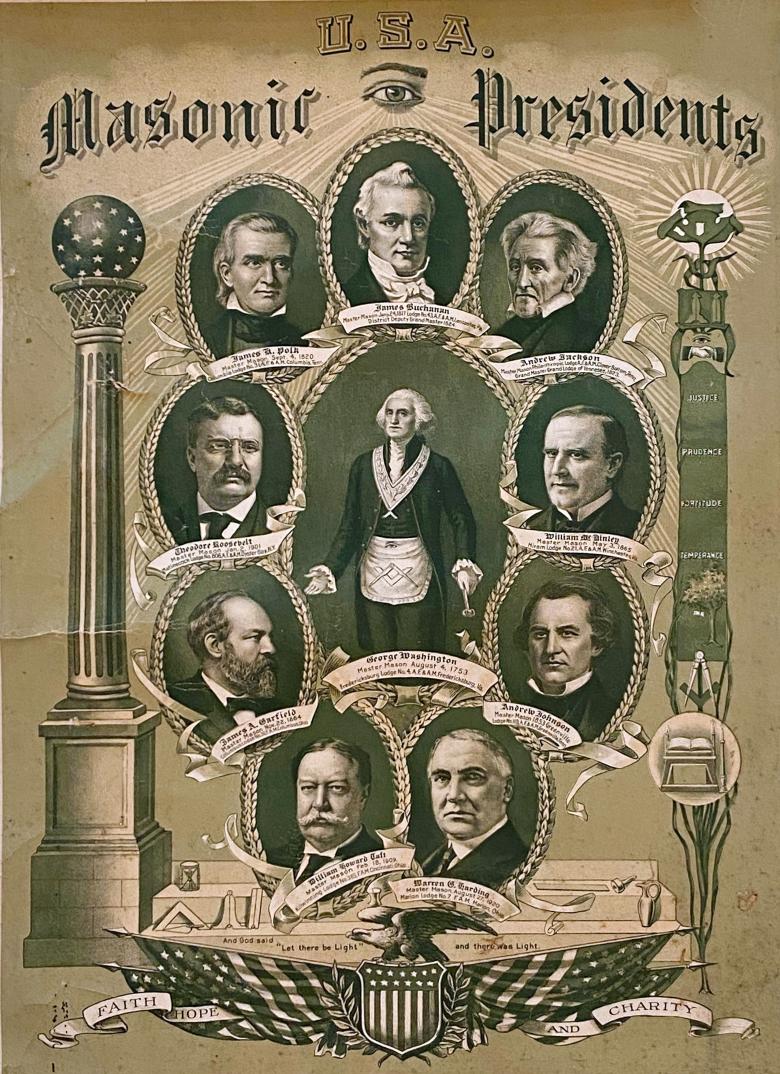President Washington and other famous Masonic Presidents of America, poster, 1921, USA.


Some of our latest news
President Washington and other famous Masonic Presidents of America, poster, 1921, USA.
Freemasonry and the philosophical ideas of the Enlightenment emerged in America during the colonial period, actually in the 1720s. Many of the founding fathers of the United States were Freemasons and transferred Masonic philosophical ideas to the political and moral structure of the USA.
Masonic ideals promoted civil liberties and ideals of democracy, which formed the basis of the Constitution and became the basis for modern civic and patriotic principles in the United States.
Thanks to the political foundations of the USA, derived from the philosophy of the Freemasons, Enlightenment ideas and humanism, Freemasonry in America did not face radical criticism or repression as, for example, in Nazi Germany or the USSR. Therefore, many statesmen did not hide their affiliation to the fraternity.
In 1921 Warren Harding became the President of the United States and by this time at least ten former presidents were Freemasons, which is reflected on the poster itself. In addition, it can be stated that a total of 15 U.S. presidents were Freemasons. Of these, the following Masonic presidents are not listed on the poster:
• James Monroe (1758-1825) — 5th President of the United States, one of the founding fathers of the United States, who actively opposed colonial European powers. He was admitted to Freemasonry in 1775 and later participated in the works of the lodge of Williamsburg, Virginia.
• Franklin Delano Roosevelt (1882-1945) — 32nd president who served for more than two terms in office, enacted economic reforms to combat the Great Depression, and led the United States during World War II. He was admitted to Freemasonry in New York in 1911 and remained an active member of the fraternity throughout his life.
• Harry Truman (1884-1972) – 33rd President of the United States, who continued the liberal economic reforms of Franklin D. Roosevelt and the reconstruction of Western Europe after World War II. Admitted to Freemasonry in 1909 and achieved the 33rd degree in the Ancient and Accepted Scottish Rite. Also served as the Grand Master of the State of Missouri.
• Lyndon Johnson (1908-1973) – 36th President of the United States, elected after the assassination of John F. Kennedy in 1963. Strenthened the Civil Rights Act, which permanently outlawed racial discrimination in the USA. He was admitted to Johnson City Lodge No. 561 in 1937, but did not advertise his membership in the fraternity.
• Gerald Ford (1913-2006) – 38th President of the United States. During his presidency he faced an economic crisis in the 1970s and signed the Helsinki Accords, ending the Vietnam War. Joined Freemasonry in 1937 in Malta Lodge No. 465, Michigan. Reached 33rd degree in 1962 in Columbia Lodge No. 3, Washington, DC.
Now let us consider the presidents depicted on the poster: in the centre of the composition is George Washington (1732-1799) - the first president of the USA, dressed in Masonic regalia: apron, collar and holding a gavel, symbolising order, law and justice. Washington was not only one of the founders of the United States, but also a prominent Freemason whose ideas of brotherhood and freedom became the basis for the future development of the nation.
Around, clockwise, are portraits of other U.S. presidents who were also members of Masonic lodges:
• James Buchanan (1791-1868) — 15th President of the United States who governed the country on the eve of the Civil War.
• Andrew Jackson (1767-1845) — 7th President and hero of the Battle of New Orleans, whose adherence to Masonic and Democratic principles led to increased power for the executive branch.
• William McKinley (1843-1901) — 25th president under whose leadership the United States began its transformation into a global industrial power.
• Andrew Johnson (1808-1875) — 17th president to hold office after Lincoln's assassination, who rebuilt the country after the Civil War.
• Warren Harding (1865-1923) — 29th President, known for his "return to normalcy" policy after World War I.
• William Howard Taft (1857-1930) — 27th president and the only person who later became Chief Justice of the U.S. Supreme Court.
• James Abram Garfield (1831-1881) — 20th president who sought to reform and unify the country after the Civil War.
• Theodore Roosevelt (1858-1919) — 26th president and reformer who embodied many progressive ideas, striving for social justice and a better life for citizens.
• James Knox Polk (1795-1849) — 11th president who expanded the territory of the United States by annexing Texas and California.
The four virtues highlighted by Aristotle are labelled on the right side of the poster:
• Justice — the pursuit of honesty and fairness.
• Prudence — the ability to make informed decisions.
• Fortitude — courage and strength in adversity.
• Moderation — control over your own passions in all aspects of life.
Below the portraits of the presidents is a quote from the Old Testament: "And God said: Let there be light. And there was light." (Genesis 1:3). This phrase symbolises the search for truth, the quest for knowledge and enlightenment, which is at the basis of Masonic teachings and the American idea of progress through enlightenment and the pursuit of a better future.
The lower part of the poster depicts the Christian virtues — Faith, Hope and Charity, which connect to the Masonic principles of moral improvement and helping one's neighbour. These virtues symbolise the need for moral self-improvement, spiritual growth and charity, which is an important part of Masonic philosophy.
Freemasonry in the United States became an environment, in which progressive and humanistic ideas spread: civic awareness, social justice, and religious freedom. Masonic lodges were meeting places for intellectuals, politicians, and leaders who participated in shaping the basic principles of American democracy and government.
 Museum
Museum